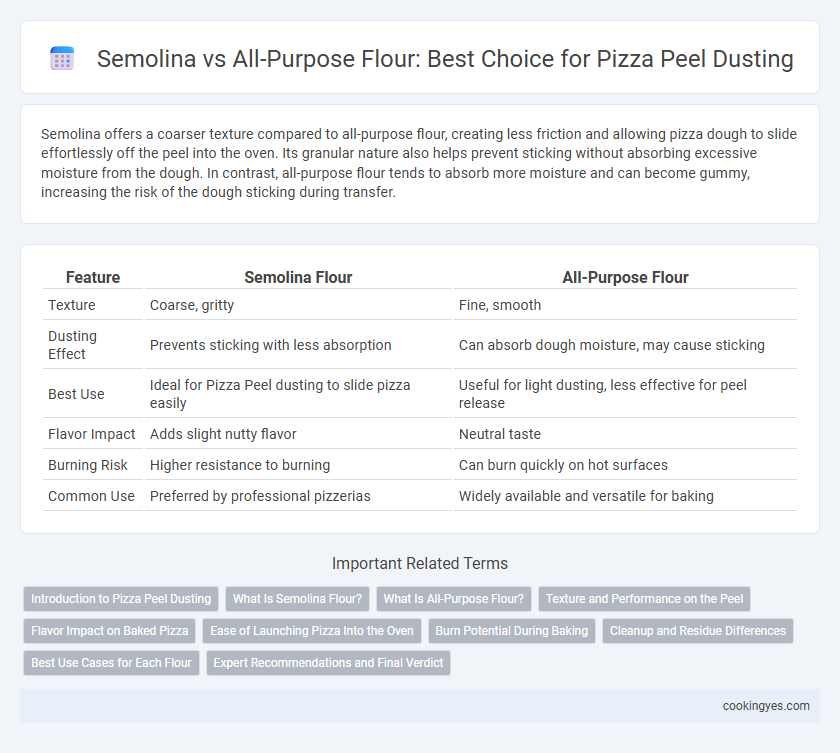Semolina offers a coarser texture compared to all-purpose flour, creating less friction and allowing pizza dough to slide effortlessly off the peel into the oven. Its granular nature also helps prevent sticking without absorbing excessive moisture from the dough. In contrast, all-purpose flour tends to absorb more moisture and can become gummy, increasing the risk of the dough sticking during transfer.
Table of Comparison
| Feature | Semolina Flour | All-Purpose Flour |
|---|---|---|
| Texture | Coarse, gritty | Fine, smooth |
| Dusting Effect | Prevents sticking with less absorption | Can absorb dough moisture, may cause sticking |
| Best Use | Ideal for Pizza Peel dusting to slide pizza easily | Useful for light dusting, less effective for peel release |
| Flavor Impact | Adds slight nutty flavor | Neutral taste |
| Burning Risk | Higher resistance to burning | Can burn quickly on hot surfaces |
| Common Use | Preferred by professional pizzerias | Widely available and versatile for baking |
Introduction to Pizza Peel Dusting
Pizza peel dusting is essential for ensuring smooth pizza transfer from peel to oven without sticking. Semolina flour offers a granular texture that creates a non-stick surface, reducing friction and heat absorption. All-purpose flour, while more common, tends to absorb moisture and can lead to sticking or burning during baking.
What Is Semolina Flour?
Semolina flour, made from coarsely ground durum wheat, is prized for its granular texture and high protein content, making it ideal for dusting pizza peels to prevent dough from sticking. Compared to all-purpose flour, semolina's coarse particles create a natural barrier that allows pizzas to slide effortlessly onto hot stones or ovens. Its unique grain size also contributes to a crispier crust edge and enhanced browning during baking, optimizing pizza quality.
What Is All-Purpose Flour?
All-purpose flour is a versatile wheat flour commonly used in baking and cooking, made from a blend of hard and soft wheat varieties to achieve a balanced protein content around 10-12%. Its moderate gluten level makes it suitable for dough elasticity and structure, ideal for pizza crust preparation and dusting to prevent sticking on a pizza peel. Using all-purpose flour for pizza peel dusting offers a fine texture that reduces the risk of burning compared to coarser alternatives like semolina.
Texture and Performance on the Peel
Semolina's coarse granules create a rougher texture on the pizza peel, offering superior grip and preventing dough from sticking during transfer. All-purpose flour provides a finer, smoother dusting but tends to absorb moisture quickly, which can cause dough to cling and impede sliding. Using semolina enhances peel performance by ensuring effortless pizza release and maintaining crust integrity.
Flavor Impact on Baked Pizza
Semolina flour enhances the flavor of baked pizza by adding a subtle nutty and slightly sweet taste that complements traditional toppings. All-purpose flour offers a more neutral flavor, allowing the natural ingredients of the pizza to dominate without interference. Using semolina for peel dusting creates a crispier, more flavorful crust edge compared to the softer texture achieved with all-purpose flour.
Ease of Launching Pizza Into the Oven
Semolina's coarse texture provides superior friction on the pizza peel, preventing dough from sticking and enabling a smoother, more controlled launch into the oven. All-purpose flour, while commonly used, tends to absorb moisture from the dough, increasing the chance of sticking and making it harder to slide the pizza. Choosing semolina dusting enhances efficiency in transferring pizza, reducing launch errors and preserving the dough's integrity.
Burn Potential During Baking
Semolina flour has a coarser texture compared to all-purpose flour, which provides better grip and reduces dough stickiness on the pizza peel without burning easily during baking. All-purpose flour, being finer, tends to burn faster on high-temperature pizza stones or ovens, leading to undesirable smoke and off-flavors. Using semolina flour for peel dusting enhances pizza release and minimizes burn potential, resulting in a cleaner bake and crisper crust.
Cleanup and Residue Differences
Semolina flour, with its coarse texture, prevents dough from sticking to the pizza peel and leaves minimal residue, making cleanup quicker and easier. All-purpose flour, being finer, can stick to the peel and dough, often requiring more thorough cleaning to remove floury buildup. Choosing semolina improves peel dusting efficiency by reducing residue accumulation and easing post-use maintenance.
Best Use Cases for Each Flour
Semolina flour's coarse texture provides superior grip and prevents dough from sticking to the pizza peel, making it ideal for launching thin-crust pizzas in high-temperature ovens. All-purpose flour, being finer and more powdery, works well for dusting when handling softer doughs or thicker crusts that require less friction and faster release. Choosing semolina flour enhances bake quality for crispy bases, while all-purpose flour is suited for everyday pizza preparations requiring smooth dough manipulation.
Expert Recommendations and Final Verdict
Experts recommend semolina for pizza peel dusting due to its coarse texture, which prevents dough from sticking and allows for easy transfer into the oven. All-purpose flour can be used but tends to absorb moisture, increasing the risk of dough sticking during baking. The final verdict favors semolina as the preferred choice for a seamless pizza launch and an evenly baked crust.
Semolina vs All-Purpose Flour for Pizza Peel Dusting Infographic

 cookingyes.com
cookingyes.com